A visit to Kiyomizu Temple
| Kiyomizu Temple (清水寺, Kiyomizudera), a Buddhist Temple in Kyoto, Japan, is a popular tourist destination. If you look in any Japan travel guidebook, you’ll probably find a photo of Kiyomizu Temple’s large, wooden “stage” (balcony) overlooking the city of Kyoto. |
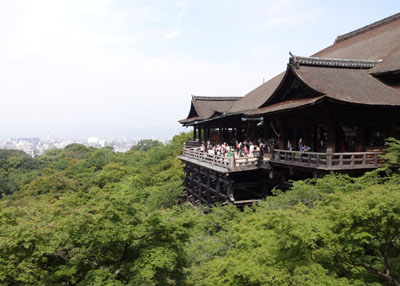 |
| We found Kiyomizu Temple at the end of a 15-minute hike up a
winding touristy street lined with gift shops. Just inside
the temple grounds, we stopped at Tainai-meguri (AKA:
Zuigudo Hall). Most tourists walk right past Tainai-meguri,
even though it is one of the most unusual and interesting
things to do in all of Kyoto. The main reason that visitors
bypass it: they have no idea what’s inside. Had I not done
my research, I would have walked past it too. Just to the left of the main entrance to Kiyomizu Temple, I saw a non-descript brown and white building and a short line of Japanese school children waiting to enter it. The only English words on the signs were “No Picture.” One sign indicated a cost of 100 yen. I assumed that this was Tainai-meguri. We joined the queue and were handed a card on which a nebulous explanation of the experience inside Tainai-meguri was written, in English. We were instructed to remove our shoes, which we deposited in provided bags; placed 100 yen coins in the dish by the woman collecting the admission fee; and followed a single-file line of people down some stairs and into the darkness. |
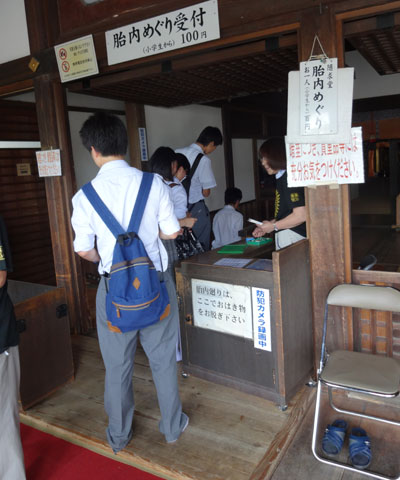 |
| No matter how they tried, my eyes couldn’t see anything at
all. As I made my way through the pitch black, the only
thing guiding me was a chain of large wooden beads. They
felt like they undulated as my hand slowly moved over them.
I might have walked straight, or I might have walked in
circles. It was hard to tell. I knew that my friend was in
front of me, but I had no idea how close or far away he was.
The experience wasn’t nearly as disconcerting as it seemed
like it should be. The beaded rope was comforting. I felt
safe. After a few minutes of walking blind, I saw a large stone. I suddenly became aware of people around me. Everyone had walked so silently through the darkness that, up until that moment, I had felt like I was alone. I joined the other people, put my hands on the cold stone, spun it, and made a wish. Then I ascended back into the daylight. [Note: Tainai-meguri is open from 9 AM until 4 PM]. We paid 300 yen each to enter the main attraction: Kiyomizu Temple. Our first stop was its "famous" balcony. Standing on the balcony was nice, but not quite the breath-taking experience that brochures and guidebooks describe. Below us, we could see people lined up to drink the temple’s sacred water (more on that later). |
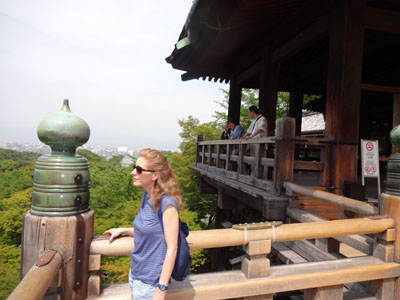 |
| Before we moved on, I stopped to admire a pot of burning
incense sticks. A group of school children stood nearby,
listening as their teacher offered a lesson, in Japanese.
Noticing my interest in the incense pot, the teacher turned
to me, and gestured that I should pick up an unburned stick
of incense. I followed his lead as he showed me how to light
it, hold it perpendicular to the layer of ash at the top of
the pot, and then let it go. My incense stick landed in the
pot sticking straight up, just like the others. I smiled and
thanked the man, who was a born teacher, even when he and
his student didn’t speak the same language. We explored the temple grounds and found the path from which most of the tourist brochure photos of the Kiyomizu Temple balcony are taken (see top photo). I liked this view better than the view from the temple’s balcony, because we could see the interesting balcony itself. We took some photos and then went in search of a small vermillion pagoda that we had spotted from the balcony. The pagoda was nestled in the trees on the outskirts of the temple grounds. |
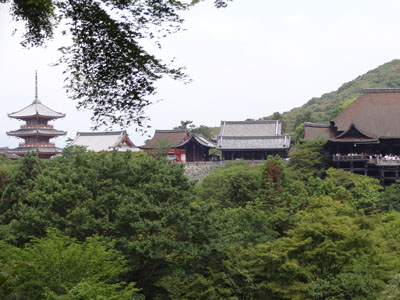 |
| After a short walk and some stair-climbing we found that the
small pagoda was much more intriguing from a distance,
although it's location did offer a nice view of the main
hall balcony with its balcony and the attractive buildings
at the temple entrance. While we were visiting the pagoda, a group of school children approached my friend and asked him if he would be able to help them with a school assignment. After confirming that he spoke English and was willing to chat with them, they asked a few questions about where we were from and our trip to Japan. They jotted down his answers in their assignment books. When they were through, they asked if they could take a photo with us. We agreed. Afterward, they obliged us by allowing us to take a photo with our cameras too! |
 |
| Kiyomizudera means “the temple of pure water.” Visitors to the temple line up to drink the sacred water from Otowa Waterfall. I joined the zigzagging queue. At the end of the line, I pulled a long metal ladle from the sterilizer. I stepped up to the stone railing, reached out with my ladle, and caught some spring water from one of the three tiny streams flowing over the roof above us. Then I did my best to properly wash each of my hands, before drinking some of the water as I made a wish. |
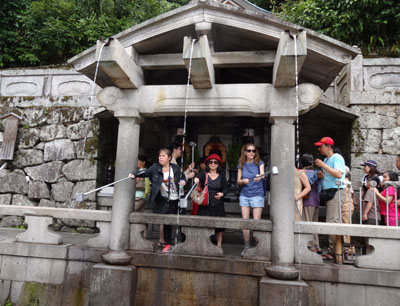
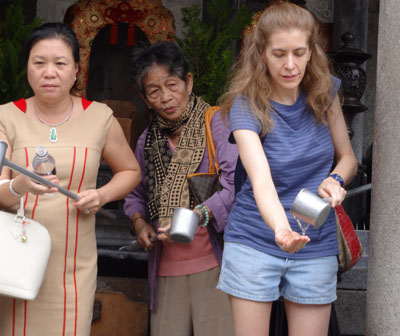 |
| Our final stop at Kiyomizu Temple was the “Love Stones” in
front of Jishu Shrine. Jishu Shrine is dedicated to the
deity of love and matchmaking. We knew we’d found the stones
when we saw a sign declaring, “Here is the Famous Love
Stone,” in multiple languages. There was also a plaque that
explained the story of the love-fortune-telling stones in
English. Apparently, if you are able to successfully walk
the approximately 18-meter distance between the two stones
with your eyes closed, you will soon find true love. If you
require assistance, then you will need help in your quest
for love. If you can’t complete the task, it will be a long
time before you find your soulmate. I placed my heels at the first stone and closed my eyes. Then slowly, carefully, I inched my way forward into the crowded plaza. |
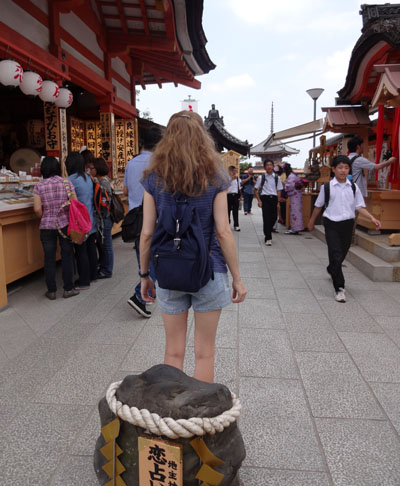 |
| In my mind, I was traveling straight, but after a few minutes, my hands touched something wooden. I knew that there were no wooden objects along my intended path. Disappointed, I turned away from the wooden object. Although I’m not one to give up, I already knew that I had failed. I kept inching forward, slowly and carefully, until I hit something with my feet. |
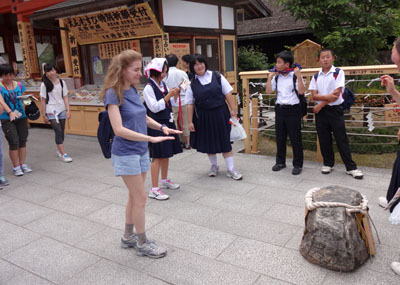 |
| People cheered around me. I opened my eyes. I was standing at the opposite love stone! I’d done it!?! |
 |
| According to my friend, I’d walked all the way to one side
of the plaza, then I’d veered off in the wrong direction for
a while, but I’d changed course and finally headed for the
stone. “You peeked, didn’t you?” my friend asked. I hadn’t. And so, although I will head in the wrong direction at first, I will eventually find my soulmate … at least according to the Kiyomizu Temple love rocks. |
I did this in 2013 in Kyoto, Japan. P.S. Read the novel inspired by my trip to Japan. Get your copy of Lost in Tokyo at Amazon.com! |
|
ABOUT THE AUTHOR Jen is also known as J.W. Lynne, a bestselling author of twelve novels. Click on any of the titles below to see the book on Amazon! THE UNKNOWN: Eight kids learn the shocking reason why they were kidnapped. ABOVE THE SKY: A girl and boy fall in love in a dangerous world filled with secrets. THE DARKNESS OUTSIDE: Ten families are locked in a bunker to take a simulated trip to the moon. KID DOCS: An experimental program transforms kids into doctors. WILD ANIMAL SCHOOL: A girl falls in love at an exotic animal ranch. WHAT HE DIDN'T TELL ME: A traumatized girl meets a boy with a horrible secret. IF I TELL: A teen wonders if her father is a serial killer. Besides reading books and dreaming up stories to write, Jen's favorite activities are singing along to musical theater soundtracks and hiking in California's beautiful parks. **Jen's books are available on Kindle Unlimited.** |
 |
|
Find more reviews of Jen's adventures in Japan here. |
|
|
